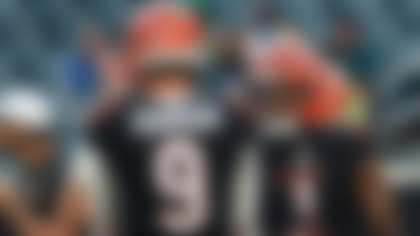Each offseason gives NFL teams a chance to adjust and craft new strategies, with those changes often helping to create opportunities for certain players to increase their production in the upcoming campaign. Using my forward-looking data models, I've identified one player from each NFL team who projects to see such an uptick in 2021 based on their performance trajectory and the scheme they'll be playing in this season.
Below, I've included a note on one player from each NFC team (listed in alphabetical order) that helps explain why these guys forecast to grow as contributors.
Training camp is finally here! Be sure to check out NFL Network's extensive live coverage, including Inside Training Camp every day and highlighted by Training Camp: Back Together Saturday Fueled by Gatorade on July 31.

As a rookie, the No. 8 overall pick pressured opposing QBs on 13.8 percent of pass rushes (eight of 58, per Next Gen Stats). Simmons' versatility coming out of Clemson was a huge factor in his NFL potential, but this projection is fueled by later-season progress, perhaps suggesting the lack of regular camp and preseason games last year initially stunted his growth. With a season under Simmons' belt -- and a real offseason in which to learn -- I can't wait to see how the Swiss Army Knife performs in this defense alongside Budda Baker, whose hyper-versatility just earned him first-team All-Pro honors.

By Pro Football Focus' count, Terrell was targeted 102 times last season (third-most in the NFL) and allowed 71 receptions for 901 yards and five touchdowns (while nabbing one interception). That stat line doesn't reflect the flashes of very good defense Terrell showed in Year 1, setting the stage for success under new Falcons DC Dean Pees. First, Terrell's pursuit-speed decrease (a computer-vision metric I use as a proxy for fatigue) improved the most of any rookie corner from Week 1 through the end of the season. Second, he got better at covering deeper routes toward the end of the season, which could be a signal that it took him some time to adapt to the NFL game. This is understandable, considering the lack of a preseason last year, as well as the lackluster supporting cast of defensive backs on the 2020 Falcons.

Last season as a Jet, Darnold was pressured on 32.6 percent of dropbacks (the fifth-highest rate in the NFL, per NGS), resulting in a 43.7 passer rating under pressure (fourth-lowest). The injury bug that ravaged Darnold's offensive line, weaponry and the quarterback himself certainly didn't help matters. The former No. 3 overall pick just seemed doomed. But that was New York, and this is Carolina. With Darnold now flanked by a better O-line, significantly better skill-position players and a savvy offensive architect in Joe Brady, the stage is set for the 24-year-old to deliver the goods.

On 11 targets of 10-plus air yards, per Next Gen Stats, Kmet had an average of just 1.6 yards of separation to work with last season. On 33 targets of fewer than 10 air yards, he averaged 4.2 yards of separation. What does this mean? Two things, really. The first is that there's an opportunity for him to improve on downfield passes -- which his QB, whoever that ends up being, will appreciate and leverage. But it also means that he's efficient close to the line of scrimmage. Impressive agility for a 6-foot-6, 262-pounder.

Lamb's 784 receiving yards from the slot equaled the second-highest total in the NFL last season, per Next Gen Stats. Now imagine a scenario where Dak Prescott stays healthy for the entire season. There's a lot to get excited about ahead of Lamb's sophomore campaign, especially with Kellen Moore heading into his third season as the Cowboys' play-caller.

The No. 3 overall pick suffered through a disastrous, injury-riddled debut campaign. Pro Football Focus charted him with a whopping 112 passer rating allowed, and he gave up completions on all 12 of the targets he faced over his final three games. But with a new defensive coordinator -- Aaron Glenn, who was an NFL cornerback for 15 seasons -- and better injury luck, Okudah can flip the script in Year 2. Assuming his health is on par with what we saw at Ohio State, his demonstrated ability to change direction and limit yards after the catch without losing speed should dramatically change his output for the Leos in 2021.

While Gary's second NFL season didn't start off stellar, he flashed down the stretch, showing up in a major way in the postseason. After grading him at a 56.8 in Weeks 1-15, Pro Football Focus gave him a robust 88.9 mark from Week 15 through the end of the season. Gary played 44.4 percent of defensive plays in 2020 (up from 23.5 percent in 2019) and netted the second-most pressures (30) and sacks (6.5) on the team. It's reasonable to assume another increase in playing time this fall will lead to an uptick in pressure production.

I had to do it. As a Michigan native who grew up a Lions fan, I've been banging the drum for Stafford for years. And I think this is the season where he finally gets the playoff win he deserves. I'm assuming that Sean McVay will dial up plenty of play-action opportunities for his new quarterback. According to Next Gen Stats, Stafford posted a 5:0 TD-to-INT ratio and a yards-per-attempt figure of 9.1 off play-action last season. Stafford was also one of just four QBs with five or more deep passing touchdowns (20-plus air yards) and zero interceptions. The others: Kyler Murray, Daniel Jones and league MVP Aaron Rodgers.

On just 43 targets last season, Smith Jr. notched five touchdowns. Now that Kyle Rudolph is a Giant, the 22-year-old will have the opportunity to absorb some of the veteran's 37 targets from last season. The story for Smith is his red-area efficiency, both on and off the ball. With an improved O-line, it's very conceivable that Kirk Cousins will look to Smith even more in the red zone, which means he's one I am already circling for fantasy purposes this season. He will very likely land among my top 10 TEs come late August.

Who doesn't love a small sample size? Me, actually -- the answer is me. This one is about opportunity, though. Trautman caught 15 of the 16 balls thrown his way last season, and if there's one thing Sean Payton is guaranteed to do, it's rewarding players who execute. The Saints' pass-catching options are limited, especially with Michael Thomas back on the shelf for now, so Trautman figures to get a shot to prove himself as an aerial threat.

The 2020 second-round pick played in just six games during his rookie season, but showcased lots of upside, getting me excited about what is likely in store for 2021. PFF notes that he was targeted 10 times in coverage, allowing seven receptions for just 47 total yards with one interception, equaling a 40.2 passer rating allowed. Additionally, his versatility (SEE: ability to play in the slot) creates even more value for this improved Giants defense.

Will Zach Ertz play another down in Philly? I have no idea. That'd be useful knowledge for fantasy, but either way, Goedert is set up to take a big step forward. In terms of run-blocking, his effectiveness is second-best in the NFL since 2018, as measured by my computer vision. Last season, Goedert lined up in the slot 30.6 percent of the time in Weeks 1-12 and 26.3 percent in Weeks 13-16 -- not too different. Over the first 12 weeks, he caught 16 balls on 22 targets, per NGS. In the last four weeks? He caught five of 11 balls. So, yeah, there's room for improvement in his rapport with second-year quarterback Jalen Hurts.

Kinlaw's official rookie stat line: 1.5 sacks, 19 pressures, three TFLs, four QB hits, one INT, one TD and four passes defensed. Relatively unremarkable rookie production, at first glance. But this is why we need analytics. OK, I'm biased, but still. The advanced data does do him more justice. Computer vision showed his burst (first 3 yards traveled on passing downs) got faster in his last six games played, and that was without Nick Bosa commanding a lot of well-deserved attention. Stunts are a source of positivity. In run defense, Kinlaw was able to shake his O-lineman and move toward the ball carrier 0.5 seconds faster on average in those last six games, as well, another good sign for future gains.

In his rookie season last year, Brooks was in coverage on 39.3 percent of snaps, according to PFF, while rushing the passer 7.9 percent of the time. On the 34 targets that came his way, he allowed 24 to be caught, 14 of which netted first downs (NGS). While Brooks' coverage wasn't very strong, the abbreviated offseason ramp-up could be to blame. Why do I say this? Because he improved as the season went on, both in terms of suffering from less fatigue (the speed drop-off from the first to fourth quarter, measured by computer vision) and being in position to make a play on the ball in coverage (as measured by his positioning at the time of the catch, again courtesy of computer vision). With more time and experience, Brooks should make big gains on Pete Carroll's defense this season, especially in coverage.

Over the past two seasons, Davis has forced 34 incompletions -- the most among corners, per PFF. Winning teams need to be able to stop the pass. Last season, there were more pass attempts on first down than ever before, and that number is likely to go up in 2021. So cornerbacks with the ability to disrupt passes -- like Davis -- will only become more crucial.

Last year, Gibson earned +64 rushing yards over expected, ranking 19th in the NFL (NGS). And Gibson's production improved as the season went on. His change-of-direction speed ranked sixth-best in the NFL (i.e., when he changed directions, his drop-off in speed eroded at the sixth-lowest rate). Gibson was a receiver in college, so it's possible we haven't even seen his ultimate efficiency potential yet, especially after contact. In the last five games he played, Gibson averaged 0.45 yards more after contact than in his first five. His center of gravity was lower in these late-season games, too, giving more backing to the notion that 2021 could be a big breakthrough season for Gibson.
Follow Cynthia Frelund on Twitter.




























